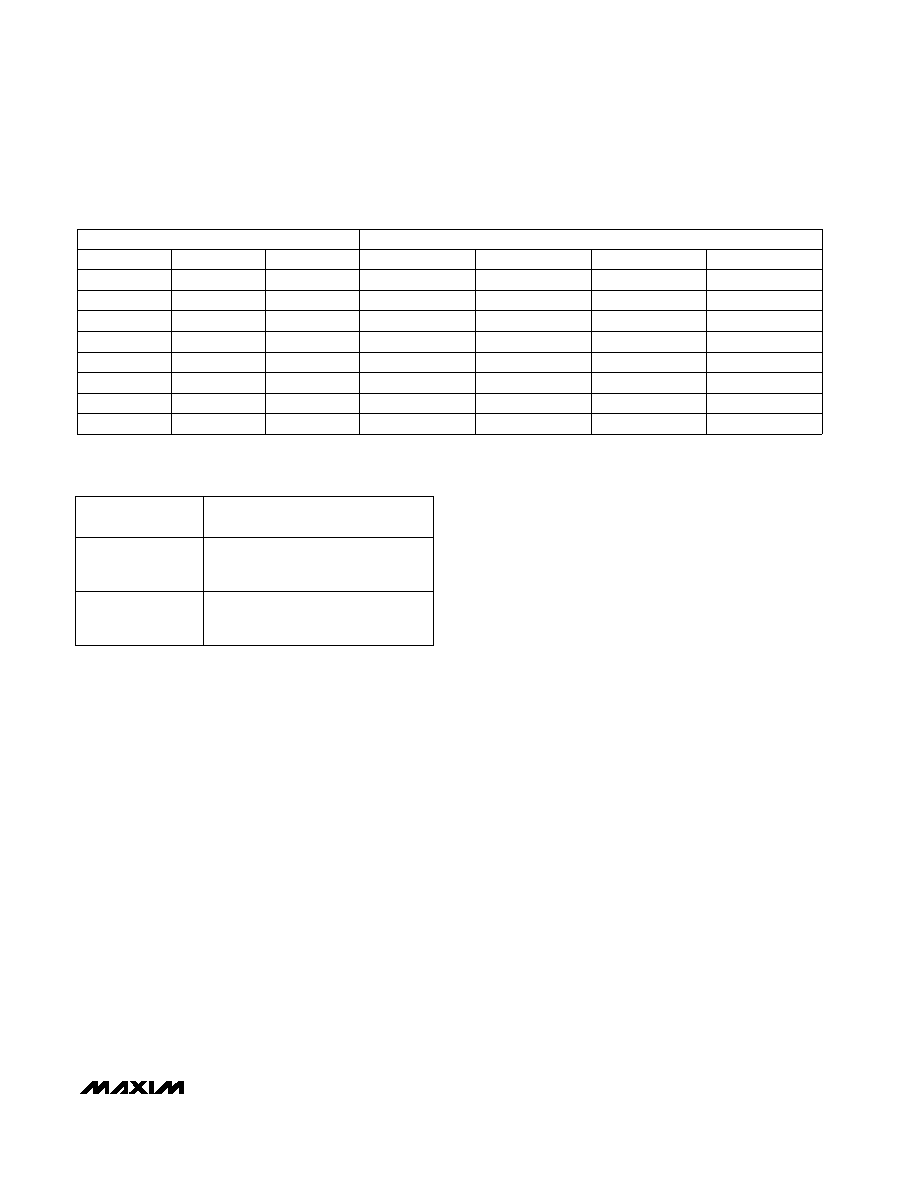- 您現(xiàn)在的位置:買賣IC網 > PDF目錄2158 > MAX5166NECM+T (Maxim Integrated Products)IC AMP SAMPLE/HOLD 32CH 48-LQFP PDF資料下載
參數(shù)資料
| 型號: | MAX5166NECM+T |
| 廠商: | Maxim Integrated Products |
| 文件頁數(shù): | 10/12頁 |
| 文件大小: | 0K |
| 描述: | IC AMP SAMPLE/HOLD 32CH 48-LQFP |
| 產品培訓模塊: | Lead (SnPb) Finish for COTS Obsolescence Mitigation Program |
| 標準包裝: | 2,000 |
| 放大器類型: | 采樣和保持 |
| 電路數(shù): | 32 |
| 電流 - 輸入偏壓: | 1µA |
| 電壓 - 輸入偏移: | 5000µV |
| 電流 - 電源: | 36mA |
| 電流 - 輸出 / 通道: | 2mA |
| 工作溫度: | -40°C ~ 85°C |
| 安裝類型: | 表面貼裝 |
| 封裝/外殼: | 48-LQFP |
| 供應商設備封裝: | 48-LQFP(7x7) |
| 包裝: | 帶卷 (TR) |

Hold Step
When switching between sample mode and hold
mode, the voltage of the hold capacitor changes due to
charge injection from stray capacitance. This voltage
change, called hold step, is minimized by limiting the
amount of stray capacitance seen by the hold capaci-
tor. The MAX5166 limits the hold step to 0.25mV (typ).
An output capacitor to ground can be used to filter out
this small hold-step error.
Output
The MAX5166 contains an output buffer for each multi-
plexer channel (32 total), so the hold capacitor sees a
high-impedance input, reducing the droop rate. While
in hold mode, the hold capacitor discharges at a rate of
1mV/sec (typ). The buffer also provides a low output
impedance; however, the device contains output resis-
tors in series with the buffer output (Figure 1) for select-
ed output filtering. To provide greater design flexibility,
the MAX5166 is available with an RO of 50
, 500, or
1k
.
Note: Output loads increase the analog supply cur-
rent (IDD and ISS). Excessive loading of the output(s)
damages the device by consuming more power than
the device will dissipate (see Absolute Maximum
Ratings). The resistor-divider formed by the output
resistor (ROUT_) and load impedance (RL) scales the
sampled voltage (VSAMP). Determine the output volt-
age (VOUT_) as follows:
Voltage Gain = AV = RL/(RL + ROUT)
VOUT_ = VSAMP AV
The maximum output voltage range depends on the
analog supply voltages available and the scaling factor
used:
(VSS + 0.75V) AV
≤ VOUT_ ≤ (VDD - 2.4V) AV
when RL =
∞, then AV = 1, and this equation becomes
(VSS + 0.75V)
≤ VOUT ≤ (VDD - 2.4V).
Timing Definitions
Acquisition time (tAQ) is the amount of time the
MAX5166 must remain in sample mode for the hold
capacitor to acquire an accurate sample. The hold-
mode settling time (tH) is the amount of time necessary
for the output voltage to settle to its final value.
Aperture delay (tAP) is the time interval required to dis-
connect the input from the hold capacitor. The inhibit
pulse width (tPW) is the amount of time the MAX5166
must remain in hold mode while the address is
changed. The data setup time (tDS) is the amount of
time an address must be maintained before the
address becomes valid. The data hold time (tDH) is the
amount of time an address must be maintained after
mode select has gone from low to high (Figure 2).
MAX5166
32-Channel Sample/Hold Amplifier
with Four Multiplexed Inputs
_______________________________________________________________________________________
7
0
Table 1. Output Selection
Table 2. Mode Selection
0
1
0
1
0
1
ADDRESS
0
1
0
1
OUT2
OUT3
OUT6
OUT0
OUT7
OUT1
OUT4
OUT5
OUT10
OUT11
OUT14
OUT8
OUT15
OUT9
OUT12
OUT13
OUT18
OUT19
OUT22
OUT16
OUT23
OUT17
OUT20
OUT21
OUTPUT SELECTED
OUT26
OUT27
OUT30
OUT24
OUT31
OUT25
OUT28
OUT29
A2
A1
A0
MUX0
MUX1
MUX2
MUX3
0 = Logic Low, 1 = Logic High
0
1
Sample mode enabled on selected
analog multiplexer and channel
(Table 1).
Hold mode enabled on selected
analog multiplexer and channel
(Table 1).
MODE-SELECT
INPUTS* (M3–M0)
ACTION
0 = Logic Low, 1 = Logic High
* Only one M_ input asserted low; all others must be logic high
to meet the timing specification (see Single vs. Simultaneous
Sampling).
相關PDF資料 |
PDF描述 |
|---|---|
| MAX5167MCCM+T | IC AMP SAMPLE/HOLD 32CH 48-LQFP |
| MAX5168NCCM+T | IC AMP SAMPLE/HOLD 32CH 48-LQFP |
| MAX9610FELT+T | IC AMP CURR SENSE 50V/V 6UDFN |
| MAX9611AUB+T | IC 12BIT ADC OPAMP COMPAR 10UMAX |
| MAX9614AXT+T | IC OPAMP GP RR 2.8MHZ LP SC70-6 |
相關代理商/技術參數(shù) |
參數(shù)描述 |
|---|---|
| MAX5167 | 制造商:MAXIM 制造商全稱:Maxim Integrated Products 功能描述:32-Channel Sample/Hold Amplifier with Output Clamping Diodes |
| MAX5167LCCM | 功能描述:采樣&保持放大器 RoHS:否 制造商:Texas Instruments 通道數(shù)量:2 捕獲時間:20 us 電源電壓-最大:18 V 最大工作溫度:+ 85 C 最小工作溫度:- 25 C 安裝風格: 封裝 / 箱體:SOIC-14 封裝:Tube |
| MAX5167LCCM+ | 功能描述:采樣&保持放大器 32Ch Sample/Hold Amp RoHS:否 制造商:Texas Instruments 通道數(shù)量:2 捕獲時間:20 us 電源電壓-最大:18 V 最大工作溫度:+ 85 C 最小工作溫度:- 25 C 安裝風格: 封裝 / 箱體:SOIC-14 封裝:Tube |
| MAX5167LCCM+T | 功能描述:采樣&保持放大器 32Ch Sample/Hold Amp RoHS:否 制造商:Texas Instruments 通道數(shù)量:2 捕獲時間:20 us 電源電壓-最大:18 V 最大工作溫度:+ 85 C 最小工作溫度:- 25 C 安裝風格: 封裝 / 箱體:SOIC-14 封裝:Tube |
| MAX5167LCCM-T | 功能描述:采樣&保持放大器 RoHS:否 制造商:Texas Instruments 通道數(shù)量:2 捕獲時間:20 us 電源電壓-最大:18 V 最大工作溫度:+ 85 C 最小工作溫度:- 25 C 安裝風格: 封裝 / 箱體:SOIC-14 封裝:Tube |
發(fā)布緊急采購,3分鐘左右您將得到回復。